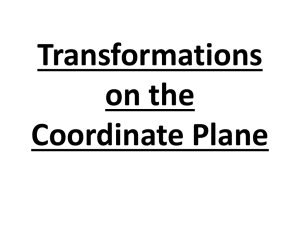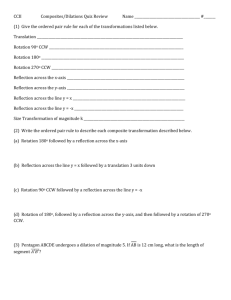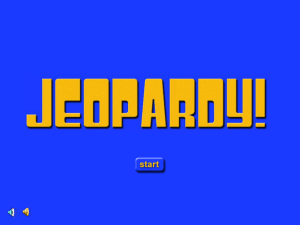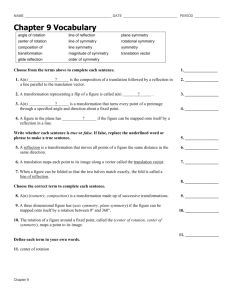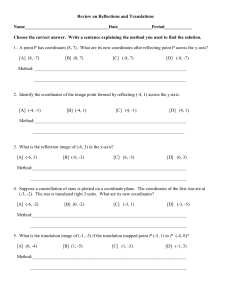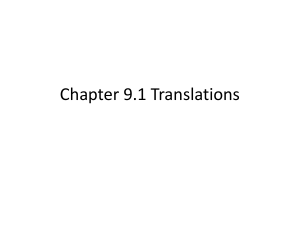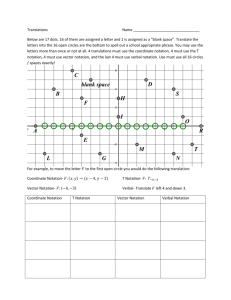File
advertisement
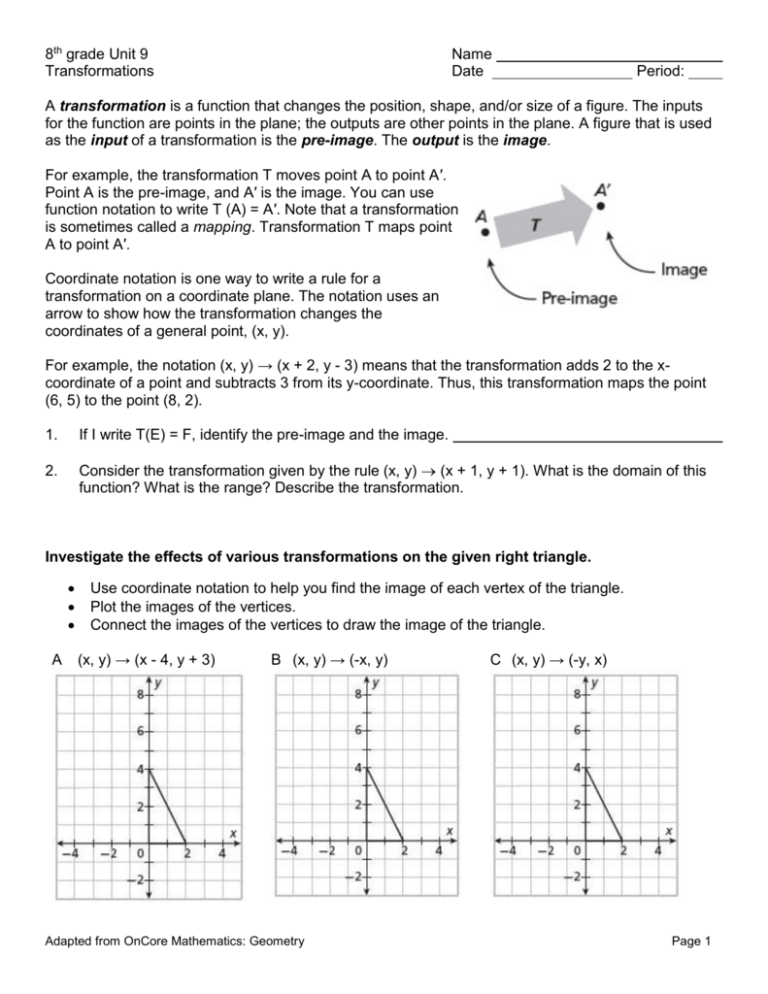
8th grade Unit 9 Transformations Name Date Period: A transformation is a function that changes the position, shape, and/or size of a figure. The inputs for the function are points in the plane; the outputs are other points in the plane. A figure that is used as the input of a transformation is the pre-image. The output is the image. For example, the transformation T moves point A to point A′. Point A is the pre-image, and A′ is the image. You can use function notation to write T (A) = A′. Note that a transformation is sometimes called a mapping. Transformation T maps point A to point A′. Coordinate notation is one way to write a rule for a transformation on a coordinate plane. The notation uses an arrow to show how the transformation changes the coordinates of a general point, (x, y). For example, the notation (x, y) → (x + 2, y - 3) means that the transformation adds 2 to the xcoordinate of a point and subtracts 3 from its y-coordinate. Thus, this transformation maps the point (6, 5) to the point (8, 2). 1. If I write T(E) = F, identify the pre-image and the image. 2. Consider the transformation given by the rule (x, y) (x + 1, y + 1). What is the domain of this function? What is the range? Describe the transformation. Investigate the effects of various transformations on the given right triangle. A Use coordinate notation to help you find the image of each vertex of the triangle. Plot the images of the vertices. Connect the images of the vertices to draw the image of the triangle. (x, y) → (x - 4, y + 3) B (x, y) → (-x, y) Adapted from OnCore Mathematics: Geometry C (x, y) → (-y, x) Page 1 D (x, y) → (2x, 2y) E (x, y) → (2x, y) F (x, y) →(x, ½ y) 3. A transformation preserves distance if the distance between any two points of the pre-image equals the distance between the corresponding points of the image. Which of the transformations A-F (above and on the previous page) preserve distance? 4. A transformation preserves angle measure if the measure of any angle of the pre-image equals the measure of the corresponding angle of the image. Which of the above transformations preserve angle measure? A rigid motion (or isometry) is a transformation that changes the position of a figure without changing the size or shape of the figure. The figures below show the pre-image (ΔABC) and image (ΔA′B′C′ ) under a transformation. Determine whether the transformation appears to be a rigid motion. 5. The transformation does not change the size or shape of the figure. Therefore ________________ 6. The transformation changes the shape of the figure. Therefore, ___________________________ Adapted from OnCore Mathematics: Geometry Page 2 Rigid motions have some important properties. These are summarized below. These properties ensure that if a figure is determined by certain points, then its image after a rigid motion is also determined by those points. Point M is the midpoint of AB . After a rigid motion, can you conclude that M′ is the midpoint of A' B' ? Why or why not? For example, ΔABC is determined by its vertices, points A, B, and C. The image of ΔABC after a rigid motion is the triangle determined by A′, B′, and C′. 7. Draw the image of the triangle under the given transformation. Tell whether the transformation appears to be a rigid motion. A (x, y) → (x + 3, y) B (x, y) → (3x, 3y) D (x, y) → (-x, -y) E (x, y)→ (x, 3y) Adapted from OnCore Mathematics: Geometry C (x, y) → (x, -y) F (x, y) → (x - 4, y - 4) Page 3 Translations A translation slides all points of a figure the same distance in the same direction. The figure shows a translation of a triangle. It is convenient to describe translations using the language of vectors. A vector is a quantity that has both direction and magnitude. The initial point of a vector is the starting point. The terminal point of a vector is the ending point. The vector at right may be named EF or v . You can use vectors to give a formal definition of translation. A translation is a transformation along a vector such that the segment joining a point and its image has the same length as the vector and is parallel to the vector. The notation Tv(P) = P’ says that the image of point P after a translation along vector v is P’. The figure below shows pre-image ABCDEFGH and translation vector PQ . Trace ABCDEFGH on patty paper and use the translation vector to draw the image of ABCDEFGH. Once you see the pattern, draw the translation on the grid below. 8. Write the coordinates of each pre-image point and its corresponding image on the point. Also write the coordinates of the endpoints of PQ . Qx – Px = ______ Qy – Py = ______ Another way to describe PQ is to describe the change in x and y coordinates. For this vector, you would write <7, -2> 9. Describe how you can use the coordinates of PQ to find the coordinates of the image. Adapted from OnCore Mathematics: Geometry Page 4 Still another way to describe the translation is to use coordinate notation (x, y) (x + 7, y – 2). Explain how vector notation <7, -2> and coordinate notation (x, y) (x + 7, y – 2) give you the same information. 10. You are going to translate this vector using the translation vector <-3, 2>. a. What does <-3, 2> tell you? b. Write this in coordinate notation c. Now draw the translated triangle on the grid to the left. d. Give a translation that would move the original triangle completely into Quadrant IV. 11. Is translation a rigid motion? Explain. 12. a. <3, -2> b. (x, y) (x – 4, y + 4) Draw the image of the figure under the given translation. Write the coordinate notation / vector notation for each. 13. Use both vector and coordinate notation to name the translation that maps ABC to A'B'C' What distance does each point move under this translation? Adapted from OnCore Mathematics: Geometry Page 5 Reflections A reflection is a transformation that moves points by flipping them over a line called the line of reflection. The figure shows the reflection of quadrilateral ABCD across line l. Notice that the pre-image and image are mirror images of each other. 14. Use a mira to draw the reflection of ABC over line l. Place the mira on line l and trace the reflection. a. Use a straightedge to trace both the pre-image and the image on patty paper. Fold along line l. Is the image actually a reflection of ABC ? b. Use your straightedge to connect corresponding points of the image and pre-image. 15. Write three things you notice about the segments AA', BB' and CC ' Read the formal definition of a reflection below. A reflection across line l maps a point P to its image P' as follows. If P is not on line l, then l is the perpendicular bisector of PP'. P is on line l, then P = P'. The notation rl (P) = P' says that the image of point P after a reflection across line l is P'. 16. What is a perpendicular bisector? Look this up in your book if you don’t have the definition in your notebook. 17. Describe how your notices from problem 15 relates to the definition above. Adapted from OnCore Mathematics: Geometry Page 6 18. The three figures below show the pre-image reflected over the x-axis, the y-axis and the line y = x respectively. Write the coordinates of two points and their corresponding reflections on each figure. Make a conjecture as to how reflection over each line affects the coordinates of the preimage points. 19. Use coordinate geometry to prove that the mirror line y = x is the perpendicular bisector of DD' (Hint: think about what a perpendicular bisector would do to DD') Reflections in a Coordinate Plane Reflection across the x-axis (x, y) ( , ) Reflection across the y-axis (x, y) ( , ) Reflection across the line y = x (x, y) ( , ) Is reflection a rigid motion? Explain. Adapted from OnCore Mathematics: Geometry Page 7 20. You are designing a logo for a bank. The left half of the logo is shown. You will complete the logo by reflecting this figure across the y-axis. Visualize in your mind what this logo should look like. Use the table to list the vertices of the left half and the reflected vertices for the right half. Then graph the vertices and complete the logo. Did your completed logo look like the one you visualized before you started? Left Half (x, y) Right Half (___, ___) (0, 4) (0, 4) 21. As the first step in designing a logo, you draw the figure shown in the first quadrant of the coordinate plane. Then you reflect the figure across the x-axis. You complete the design by reflecting the original figure and its image across the y-axis. Original (x, y) Reflect on x-axis (___, ___) Reflect original on y-axis (___, ___) Reflect 1st reflection on y-axis (___, ___) 22. When point P is reflected across the y-axis, its image lies in Quadrant IV. When point P is reflected across the line y = x, its position does not change. What can you say about the coordinates of point P? Adapted from OnCore Mathematics: Geometry Page 8 Rotation A rotation turns all points of the plane around a point called the center of rotation. The angle of rotation tells you the number of degrees through which points rotate around the center of rotation. The figure shows a 120° counterclockwise rotation around point P. When no direction is specified, you can assume the rotation is in the counterclockwise direction. While rotations can be any degree and around any point, we will focus on rotations about the origin, particularly rotations of 90, 180, and 270 counterclockwise about the origin. For each rotation below, focus on the pre-image points A, B, C and D and their images. Find the coordinates of these 4 pre-images and the coordinates of C’ and D’. Identify how the rotation affects the coordinates of the image. Predict the coordinates of A’ and B’ and verify your prediction. Rotation 90 about the origin 23. (x, y) ( , ) Predicted A’ ______ Predicted B’ ______ Adapted from OnCore Mathematics: Geometry Rotation 180 about the origin 24. (x, y) ( , ) Predicted A’ ______ Predicted B’ ______ Page 9 Rotation 270 about the origin 25. (x, y) ( , ) Predicted A’ ______ Predicted B’ ______ Summary: Rotations in a Coordinate Plane Rotation of 90 (x, y) ( , ) Rotation of 180 (x, y) ( , ) Rotation of 270 (x, y) ( , ) Is rotation a rigid motion? Explain Draw the image of the figure after the given rotation. Make a table showing the coordinates to help 26. 180 27. 90 28. 270 29. Reflect JKL across the x-axis. Then reflect the image across the y-axis. Draw the final image of the triangle and label it J '' K '' L''. Describe a single rotation that maps JKL to J '' K '' L'' Prove this using coordinate notation for any point (x, y) Adapted from OnCore Mathematics: Geometry Page 10
